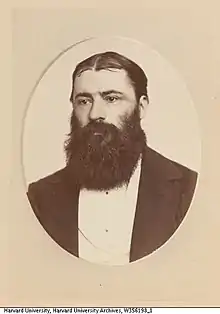James Mills Peirce
James Mills Peirce (May 1, 1834[1] – March 21, 1906[2]) was an American mathematician and educator.[1] He taught at Harvard University for almost 50 years.[3]

Early life and family
He was the eldest son of Sarah Hunt (Mills)[3] Peirce and Benjamin Peirce (1809–1880), a professor of astronomy and mathematics at Harvard University.[1] The family was considered part of the Boston Brahmin elite class. The surname is pronounced to rhyme with "![]() purse ".[4] Benjamin Peirce's father, also named Benjamin, was librarian at Harvard.[5] James had four younger siblings; one brother was philosopher, logician and professor Charles Sanders Peirce (1839–1914).[3] Another brother was Herbert Henry Davis Peirce (1849–1916) who was the First Secretary of the American Embassy in Saint Petersburg, Russia, at the end of the 19th century.[2]
purse ".[4] Benjamin Peirce's father, also named Benjamin, was librarian at Harvard.[5] James had four younger siblings; one brother was philosopher, logician and professor Charles Sanders Peirce (1839–1914).[3] Another brother was Herbert Henry Davis Peirce (1849–1916) who was the First Secretary of the American Embassy in Saint Petersburg, Russia, at the end of the 19th century.[2]
J. M. Peirce graduated from Harvard College in 1853.[1] While an undergraduate at Harvard, he was a member of the Hasty Pudding Club.[1] He attended Harvard's law school for one year.[3] In 1857, he enrolled at the university's Divinity School and graduated in 1859.[3]
Career
Like his father, James Mills Peirce became a professor of mathematics and astronomy at Harvard.[1][6] He was first a Tutor in Mathematics, then a proctor at Harvard.[3] He was a preacher in Boston and Charleston, South Carolina, but eventually returned to academia, first as Assistant Professor of Mathematics in 1861.[3] He was promoted to University Professor of Mathematics in 1869, then to Perkins Professor of Astronomy and Mathematics — the same position his father once held — in 1885. He was head of the Graduate Department at Harvard from 1872 to 1895 (becoming its dean when it was converted to the Graduate School). He was the Dean of the Faculty of Arts and Sciences from 1895 to 1898.[3]
Among his publications are Mathematical Tables Chiefly to Four Figures (1896)[6] and A Text-Book of Analytic Geometry; On the Basis of Professor Peirce’s Treatise (1857).[1] He was considered a world authority on quaternions.
Notes and references
- Kennedy, Hubert (Winter 1978). "The Case for James Mills Peirce" (PDF). Journal of Homosexuality (Six Articles on James Mills Peirce (2003)). 4 (2): 179–184. doi:10.1300/j082v04n02_04. PMID 368227.
- Kennedy, Hubert (1979). "James Mills Peirce and the Cult of Quaternions" (PDF). Historia Mathematica (Six Articles on James Mills Peirce (2003)). 6 (4): 423–429. doi:10.1016/0315-0860(79)90028-4.
- Kennedy, Hubert (1979). "Towards a Biography of James Mills Peirce" (PDF). Historia Mathematica (Six Articles on James Mills Peirce (2003)). 6: 195–201.
- "Note on the Pronunciation of 'Peirce'". iupui.edu. Peirce Project Newsletter. December 1994.
- Kennedy, Hubert (November–December 1982). "Reputations reconsidered" (PDF). Harvard Magazine (Six Articles on James Mills Peirce (2003)). 85 (2). pp. 62–64.
- "James Mills Peirce: 'Professor X'". outhistory.org. Digital Humanities Initiative, The New School. Retrieved October 17, 2017.